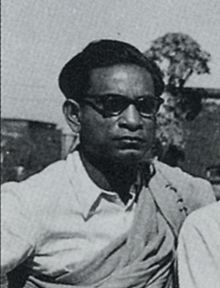Quamrul Hassan
| Quamrul Hassan | |
|---|---|

Quamrul Hassan in 1955
|
|
| Born | 1921 Calcutta, British India |
| Died | 1988 (aged 66–67) Dhaka, Bangladesh |
| Nationality | Bangladeshi |
| Education |
Calcutta Madrasa University of Calcutta (1947) |
| Occupation | Artist |
| Awards | Independence Day Award (1979) |
Quamrul Hassan (Bengali: কামরুল হাসান, 1921–1988) was a Bengali artist. Hassan is often referred to in Bangladesh as Potua, a word usually associated with folk artists, due to his down to earth style yet very modern in nature as he always added Cubism other than the folk style to his artworks. In addition to his artistic legacy, two of Hassan's work have come to be part of Bangladesh's political history. The first of this is a monstrous rendition of Yahya Khan, the Pakistani president who ordered genocide in Bangladesh. The second was just before his death, mocking the then dictator of Bangladesh, Hossain Mohammad Ershad. This sketch was titled Desh aaj bisshobeheyar khoppre (Our land is now in the hand of the champion of shamelessness).
Hassan was born in Kolkata on 2 December 1921. His father, Muhammad Hashim, was superintendent of the a local Graveyard. He belonged to a conservative family and his father always opposed to his involvement in paintings. But Quamrul's determination and love for painting made his father enroll Quamrul to Government Institute of Arts (now Government College of Art & Craft), in 1938, under the condition that Quamrul had to pay for his own tuition fee. After his enrollment to the school, Quamrul kept himself busy with not only arts but with other activities such as sports and the Bratachari movement in 1939 and he also joined ARP during the First World War. He developed connections with the Froward Block, Gononatya Andolon (People's Theatre) and even with several leaders of the Communist Party, got involved with the task of teaching of children and teenagers and contributed to illustrations in publications.
As a result of his involvement in social and cultural activities, he finished his six-year course in the Art School in nine years. He graduated in 1947. He secured first position in the B Group of the Inter College Bodybuilding competition in 1945. He had become a 'Nayak' of the Bratachari movement. After the partition of India, Quamrul, who was still a student, along with his mother and siblings moved to Dhaka, the then capital of East Pakistan.
...
Wikipedia
